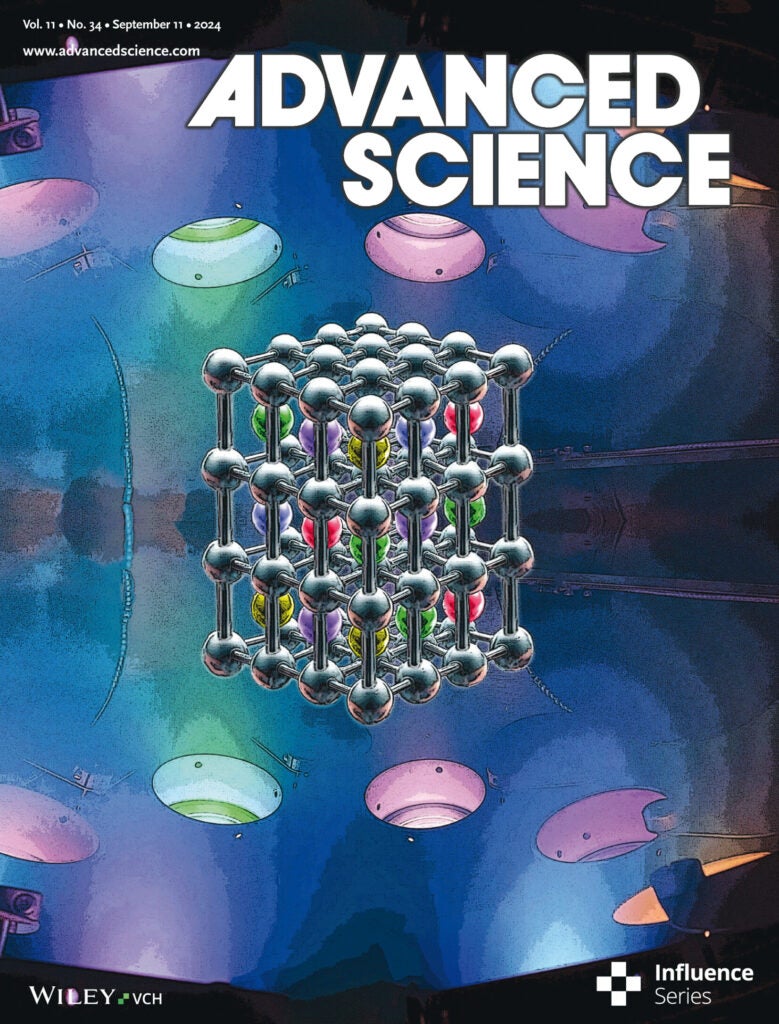“Spotlight” on Magnetic High Entropy Alloys
Posted in News Story

A team of researchers led by graduate student Willie Beeson in Prof. Kai Liu’s group in the Physics Department of Georgetown University has demonstrated a novel approach to achieve strong magnets using high entropy alloys, without relying on the traditional ingredients of rare-earth elements. Their results have been published recently in Advanced Science and featured on the journal cover.
Strong magnets are essential to numerous technologies, from magnetic recording media for data storage to permanent magnets for electric vehicle motors, wind turbines, and consumer electronics. Their unique magnetic behavior stems from their preference to remain magnetized in certain directions, a property known as magnetic anisotropy. A critical issue in today’s magnet technology is the reliance on rare-earth elements, which are costly and prone to supply chain risks, making the search for rare-earth-free high performance magnets of paramount importance, especially for the development of sustainable technologies.
Currently, rare-earth-free magnets such as the tetrataenites face serious barriers due to their poor thermodynamic stability. High entropy alloys, which incorporate many elements in high concentrations, instead utilize entropy as a driving force for stabilization, opening a vast and largely unexplored space for the discovery of novel magnets.
While most high entropy alloy studies have focused on fully disordered bulk solid solution phases, which show excellent mechanical properties but generally low magnetic anisotropy, this study by Prof. Kai Liu, Prof. Gen Yin, and collaborators demonstrates that, under certain conditions, high entropy alloys can exhibit stable, chemically ordered single phases with exceptional magnetic properties.
Using multi-source magnetron sputtering, Beeson has synthesized high entropy alloy thin films of FeCoNiCuMn on suitable substrates, and induced large strain in the films using rapid thermal annealing. The innovative approach resulted in the formation of a single crystalline phase and a 40 fold increase in magnetic coercivity, indicating a significant magnetic anisotropy not seen in the bulk material. Additionally, the inclusion of Pt in the films led to the formation of a highly ordered L10 single phase after rapid thermal annealing, where Pt and the high entropy FeCoNiCuMn mixture occupy distinct lattice sites of a tetragonal unit cell. This new phase exhibits a high magnetic anisotropy and a coercivity increase by three orders of magnitude compared with the fully disordered state.
Theoretical studies carried out by postdoctoral fellow Dinesh Bista and Prof. Yin probed the dependence of the film magnetic properties on the alloy composition and confirmed the experimental trend. Microstructural characterizations performed by Drs. Huairuo Zhang, Sergiy Krylyuk, and Albert V. Davydov at the National Institute of Standards and Technology further verified the L10 phase, using atomic resolution scanning transmission electron microscopy and electron diffraction.
This study demonstrates a new avenue for developing functional magnetic materials, putting the spotlight on the potential of high entropy alloys to host novel types of magnets. A patent application has been filed.
This work was supported by the National Science Foundation, the Advanced Cyberinfrastructure Coordination Ecosystem: Services & Support (ACCESS) program, and the National Institute of Standards and Technology.

